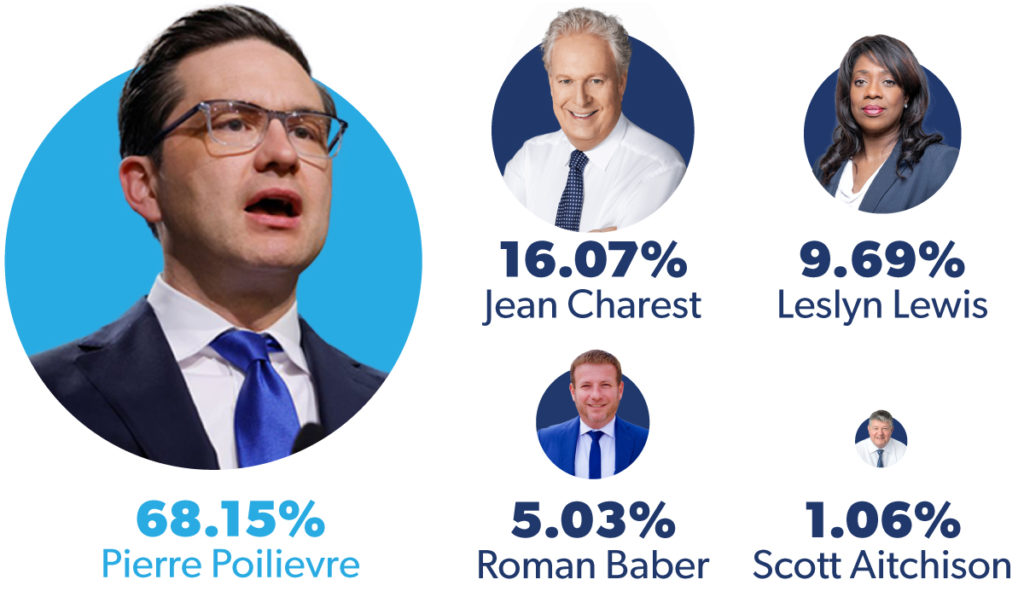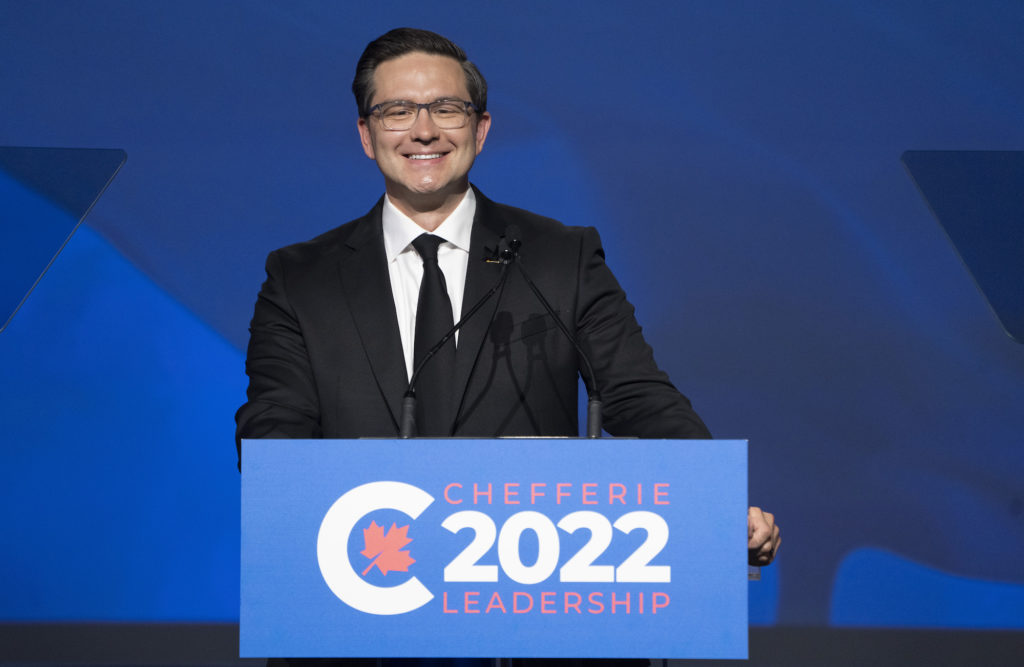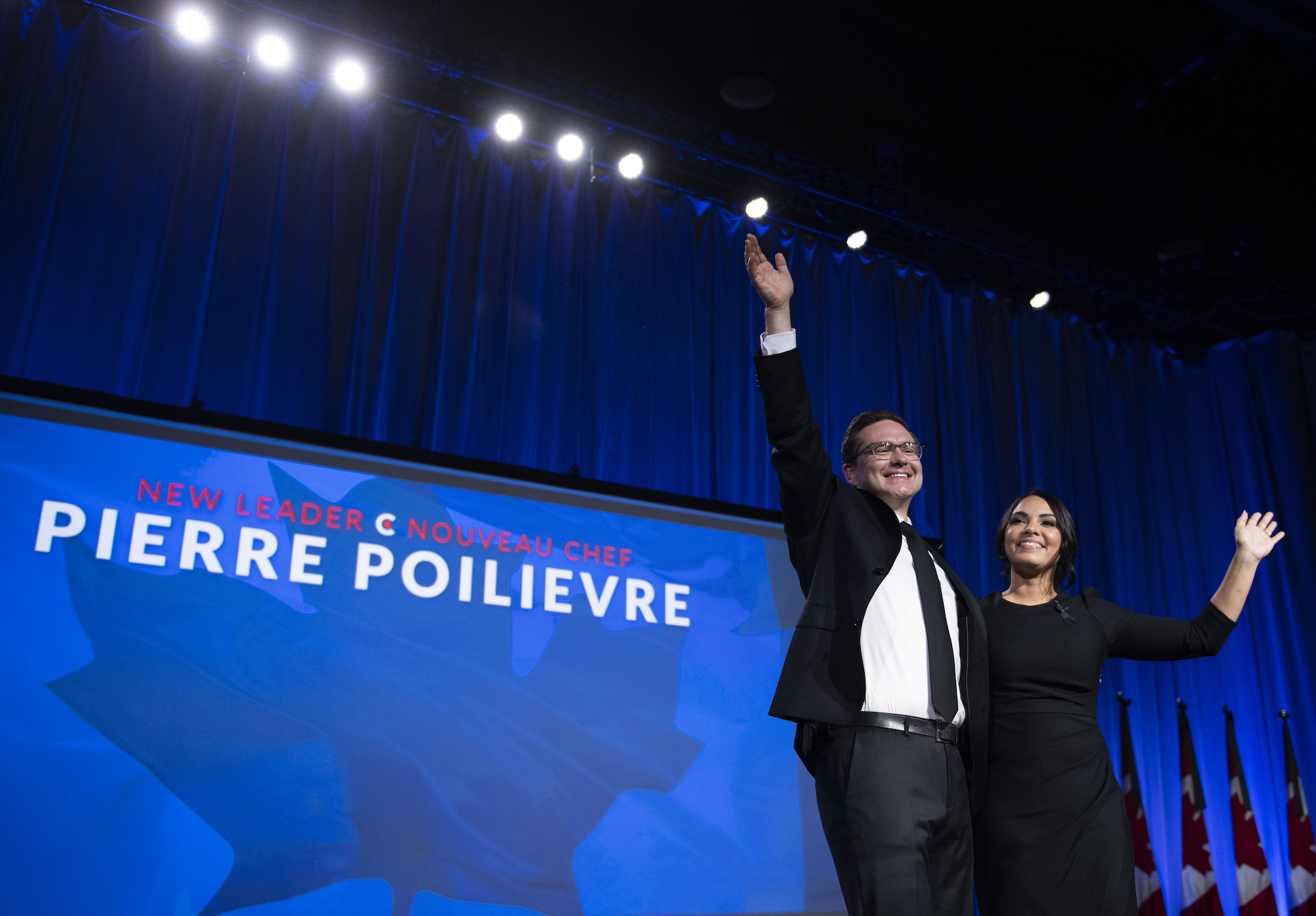Pierre Poilievre elected Conservative Party leader
On Saturday evening, Pierre Poilievre scored a massive victory to become the new leader of the Conservative Party of Canada (CPC), taking 68.15 per cent support on the first ballot. His convincing win brings to a close the third leadership contest for the party in the last five years and provides him with a strong mandate to take the party in new directions.
Results of the voting
Of the 678,000 party members who were eligible to vote in the leadership, 417,987 cast valid ballots, more than in the last two leadership campaigns combined and the largest number of people to ever vote in a leadership election of any party.
Members voted through a ranked transferable ballot, with each riding worth up to 100 points if it has at least 100 members, with a potential total of 33,800 points up for grabs. The winning candidate needed 50%+1 of those points to win, or 16,901 points.
Here are the first ballot results, which reflect each candidate’s share of the points:

Detailed riding by riding results can be found here. They indicate Poilievre’s win was as broadly based across the country as it was massive. He won the points race in every province. In fact, he even won every riding but 8 of the 338 constituencies across Canada. Jean Charest led the vote in only six Quebec ridings, his home province and supposed stronghold. Outside Quebec, Charest also won in Ottawa Centre and University Rosedale in Toronto.

Poilievre’s speech
In his victory speech, he took the first necessary steps towards binding up the wounds of the leadership contest with generous and gracious comments about the other contestants, particularly Jean Charest, paying tribute to his personal contributions to Canadian unity: “You have made Canada your project and our nation is every grateful.” This was an important gesture politically, and one that many party-watchers were uncertain would happen, given the acrimony that had developed reciprocally between Poilievre and Charest during the campaign. In the end, Mr. Poilievre paid particular attention to Mr. Charest whom he effectively lauded as a national hero.
In response, Michael Coates, co-chair of the Charest campaign, wrote in a National Post op-ed yesterday:
“Jean will not run as a candidate in the next federal election, but he and the campaign team will remain staunch Conservatives. And, there won’t be any talk among the colleagues I brought to this race about forming a separate party. The Conservative Party is our home. The membership has spoken. It is time for partisans to do what we do best: Unite behind our new leader and campaign to form the next government.”
In its tone, Mr. Poilievre’s speech softened the harshness of some of his language in the campaign, but he gave clear indications of how he will take the fight to the Liberals and make his appeal to voters on the cost of living:
“Tonight begins the journey to replace an old government that costs you more and delivers you less — with a new government that puts you first. Your paycheque. Your retirement. Your home. And your country. By tackling Liberal inflation, we’ll put you back in control of your money and your life.”
“(Canadians) don’t need a government to run their lives. They need a government that can run its own passport offices. They need a prime minister who hears them and offers hope that they can again afford their homes, their bills, their food and a secure retirement. I will be that prime minister.”
In a speech to caucus this morning, Poilievre stressed the personal impacts of inflation on individual Canadians and vowed to fight the prime minister and the “Liberal-NDP coalition” over the government’s planned higher payroll taxes and increases to the carbon tax slated to take effect on January 1, 2023: “Canadians are out of money, and the prime minister is out of touch.” He repeated his campaign pledge to require the government to budget like families must, only spending more money when other expenditures have been cut.
Background
From the start, the campaign was billed by many observers as a “fight for the soul of the party” and in many respects, it lived up to that expectation. The seeds of party discontent that led to the leadership contest were sown in last fall’s federal election, which saw the Conservatives once again limit the Liberals to a minority but lose three seats. Party members were divided over what had gone wrong. Centrist conservatives lauded the moderate approach of veering to the centre to attract more Liberal-Conservative swing voters. but lamented the Liberals’ success in wedging the party over gun control, vaccine mandates and whether CPC MPs had been vaccinated against COVID-19. Other party members, including a clear majority of MPs, viewed the platform championed by then leader Erin O’Toole as “Liberal-lite,” preferring a sharper and crisper set of alternatives and a more populist positioning.
These divisions over strategic direction played a major role in the caucus decision to dismiss Mr. O’Toole from the leadership in February. The same divisions were replayed – and played to – by the contestants throughout the leadership campaign, with Pierre Poilievre appealing to the ”true-blue” and populist elements of the party and Jean Charest arguing for the electability of more appealing centrist “Red Tory” policies.
How Poilievre won
From the outset, Pierre Poilievre believed that his path to victory lay in forging a coalition between disaffected Canadian populists fed up with big and intrusive government and those concerned about inflation and rising cost of living issues. He cast himself as the anti-establishment outsider and as the dependable agent of real change, opposing Jean Charest whom he characterized as representing the Canadian establishment.
Under the banner “Take back control of your life,” Poilievre made “freedom” the centrepiece of his campaign, specifically rejecting the federal government’s record of big spending and interference in people’s lives through the pandemic restrictions, and especially vaccine mandates, which he promised to end and prohibit in the future. He endorsed the concerns of the truckers’ “freedom convoy” that brought Ottawa and several key border crossings to their knees last winter.
He waged a rhetorical war on the “gatekeepers” of Canadian society, “the consulting class, politicians, bureaucrats, or agencies (that) create roadblocks for progress and charge a hefty fee for anyone who would want to build anything.” If elected prime minister, he promised to fire Bank of Canada Governor Tiff Macklem, who he blamed for financing Liberal COVID-inspired deficits and vowed to replace him “with a new governor who would reinstate our low-inflation mandate, protect the purchasing power of our dollar and honour the working people who are in those jobs.”
On the substantive policy front, his principal focus in the campaign was inflation and the rising cost of living, which he proposed to tame through “pay as you go” legislation that would force the federal government to offset every dollar of new spending with a cut to something else. The legislation would require the government to find money for new measures within existing budgets, rather than increasing the debt and taxes to cover new costs. Spending increases that were previously budgeted, such as the annual increase to the Canada Health Transfer and higher military spending would be exempt. He would leave in place existing supply management programs that provide for steady increases in the prices for many food commodities.
To increase the supply of housing and lower its cost, he pledged to remove municipal barriers by withholding federal funds from cities that do not increase the supply of new homes by at least 15 per cent annually. He also promised to offer a bonus to municipalities who do build new homes and to make federal government owned land more available for housing construction.
On climate change and energy policy, he promised to repeal the Liberal’s carbon tax and their environmental impact assessment law and replace it with a faster regulatory regime. He would also repeal Bill C-48, which bans tankers traffic along British Columbia’s north coast. In addition, he would ban oil imports from countries like Saudi Arabia and Venezuela and would support rail and pipeline projects to move Canadian oil from west to east.
Jean Charest brought a lifetime of political leadership and experience to the contest, first as a federal cabinet minister in the Mulroney years and then as a three-term premier of Quebec over nine years. His positioning was straightforward, that the road to victory for the party lay in moderation and centrist policy solutions to the challenges facing the country.
Throughout the campaign, Charest billed himself as a consensus-builder and advanced thoughtful and balanced positions on climate change and energy, child-care policy, pension reform, gun control and gun crimes, health care financing, cyber-security, defence spending, housing and immigration. As substantive and attractive as these proposals were, they appealed much more to the broader Canadian electorate than to party members, and the first rule of party leaderships is that they are won within the party – either by tweaking messages to those who already have a party membership or by selling lots more memberships. In the end, the party overwhelmingly opted for a clearer and more forthright delineation of Conservative principles and alternatives.
The new leader’s immediate agenda
Key advisors
- Two individuals will be the most important advisors to the new leader: his wife Anaida, who introduced him after his victory on Saturday night; and Jenni Byrne, who served as campaign manager for the party during the Harper years and was the key behind the scenes architect of Poilievre’s leadership run. Courtesy of Politico, here’s a profile of Byrne.
Continuing to put the Party back together
- The leadership contest has been long and at time fractious, so he will be making calls to reach out to Party elders and the leaders of the various factions to mend fences and bring them on board. The overtures in his victory speech were important, but much of the post-race healing is done through strategic appointments and direct outreach.
Get ready for the re-opening of Parliament
- Parliament returns on Thursday, September 15 for a tribute to Her Late Majesty, and Mr. Poilievre will want to have his Shadow Cabinet in place by then. He was actively working on this on Sunday. With 62 members of the CPC caucus having supported him, he has lots of room to manoeuvre. Here’s a National Post assessment of whom to watch in caucus.
Make key appointments
- He needs to decide on the key positions in his office and at the Party, such as Principal Secretary, Chief of Staff, Directors of Policy and Communications, Campaign Chair. the Party’s Director of Fundraising, and the chair of the party’s Fund.
- The Party’s policy support staff needs to be replenished after many were let go following the dismissal of Erin O’Toole as leader earlier this year, and not replaced given the inevitability that a new team would be coming in in September.
Policy development process
- In the longer term, he needs to put in place an inclusive policy development process to create a platform for the next election that involves the caucus and Party members. That process needs to avoid the mistakes Erin O’Toole made in 2021 when he “sprang” an election platform on an unsuspecting caucus that had not been involved in its development and disagreed with much of its direction.
Afterword
All recent Conservative leadership contests have presented the party with the same set of challenges. For the most part, urban Canada is a moderately left-leaning country, with its majorities consistently expressing liberal social, political and economic attitudes; small-town and rural Canada tends to be conservative in its political outlooks, and suburban Canada tends to toggle between the two. The Canadian editorial consensus has traditionally been dominated by the metropolises, however, and harnessing this “Laurentian elite” consensus has enabled the Liberals to form government for 45 of the last 70 years.
At the same time, many Conservative supporters and as a result, their MPs, tend to be concentrated in small towns and rural areas of the country, where distance and isolation often result in alienation and disaffection from mainstream views. Electing a leader therefore requires bridging the gulf between party members principally motivated by protest and Conservatives who seek to form a government based on centrist policies and positions. This generally involves a two-step process for the leadership contestants: veering populist to win the leadership within the party, and then moving back toward the centre to win the country. Recent successful Conservative leaders – Brian Mulroney and Stephen Harper – were able to negotiate this transition, Andrew Scheer and Erin O’Toole did not.
In winning the leadership, Pierre Poilievre has given every indication that he does not intend to move the party toward the centre as the next election approaches. He also knows that party members who have signed on for a specific hard-edged approach have a habit of showing up carrying pitchforks it they sense a “bait and switch” is afoot. At the same time, his hugely successful recruitment (312,000 new members), the large crowds he has attracted and his apparent appeal to younger voters, all suggest he has broadened the party’s base to new groups of potential voters. He is also going up against a Liberal party that has suffered declining voter support in six of the seven federal elections since 2004, including two of Justin Trudeau’s three as leader.
We will see how the new leader navigates these shoals. Ontario Premier Doug Ford followed a similar route to power, a non-nonsense folksy populism defining his leadership ascendancy. He followed that with a pragmatic approach to governance while still preserving the tone of a populist leader governing to validate the forgotten and ignored. Among the available comparators in Canadian politics, this approach – also a traditional recipe for success by provincial NDP governments on the Prairies – is the most likely formula to expect.
